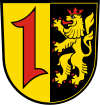Mannheim
![]()
The title of this article is ambiguous. For other meanings, see Mannheim (disambiguation).
The university city of Mannheim (Electoral Palatine Mannem [manəm], also Monnem) is an urban district with 309,119 inhabitants (July 31, 2020) in the Karlsruhe administrative district in Baden-Württemberg. It is the second largest city in the state after Stuttgart. The former residence city (1720-1778) of the Electoral Palatinate with its city-defining Baroque palace, one of the largest palace complexes in the world, forms the economic and cultural center of the Rhine-Neckar metropolitan region with 2.35 million inhabitants.
Mannheim is located directly in the border triangle with Baden-Württemberg, Rhineland-Palatinate and Hesse. Mannheim is separated from its Rhineland-Palatinate sister city Ludwigshafen am Rhein, with which it forms a contiguous urban area, by the Rhine.
First mentioned in documents in the Lorsch Codex in 766, Mannheim was granted city privileges in 1607 after Elector Friedrich IV of the Palatinate laid the foundation stone for the construction of the Friedrichsburg fortress. The grid-like street network with blocks of houses instead of streets, which was laid out at that time for the burgher city of Mannheim connected to the fortress, has been preserved in the city center. The name "square city" can be traced back to this.
A major city since 1896, Mannheim is now an important industrial and commercial city, a university town, and a major transportation hub between Frankfurt am Main and Stuttgart, including an ICE interchange, Germany's second-largest marshalling yard, and one of the most important inland ports in Europe.
Many important inventions originated in Mannheim:
- Karl Drais built the first two-wheeler here in 1817,
- In 1880, Werner von Siemens presented the first electric elevator,
- In 1886, Carl Benz's first automobile rolled along the roads,
- In 1921, the Lanz Bulldog followed.
- 1971 First use of converters in locomotives by Werner Teich
Andreas Flocken, the inventor of the first German electric car, also worked at the Heinrich Lanz AG agricultural machinery factory. In 1924, Hugo Stotz received a patent for the invention of the circuit breaker. Julius Hatry from Mannheim designed the world's first rocket plane in 1929.
Here, as early as the 18th century, standards were established for the worldwide collection of weather data. These include the times of day for measurement, known as the Mannheim Hours.
As early as 1868, the Revised Rhine Navigation Act of October 17, 1868 was signed in Mannheim, in which all German states and France declared themselves in favor of duty-free Rhine navigation. This treaty is also known today as the Mannheim Act.
With the National Theater Mannheim, known as the Schillerbühne, the Kunsthalle Mannheim, the Reiss-Engelhorn Museums and the Technoseum, Mannheim is a nationally important theater and museum location. The Pop Academy Baden-Württemberg and a lively music scene also make Mannheim an important center of German pop music; since 2014, Mannheim has been a UNESCO City of Music. It is also a modern continuation of the Mannheim School, which brought many musicians (including Wolfgang Amadeus Mozart) to Mannheim as early as the mid-18th century and enriched the music scene of the time.
Mannheim is also known for its university, which is one of the best business universities in Germany and repeatedly receives top marks, especially in the subject of business administration. Furthermore, Mannheim is also home to a university, the Federal University of Applied Sciences with its Department of Armed Forces Administration, a music academy, a dual university, a university of the Federal Employment Agency and a medical faculty of the University of Heidelberg.
Mannheim is located on the Burgenstrasse, is the starting point and destination of the Bertha Benz Memorial Route and part of the Road of Democracy.
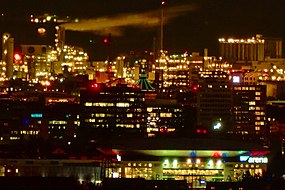
The water tower with green glowing stripes on its roof in the center of the picture with the SAP Arena placed 3.8 km in front of it and the bright industrial background of Ludwigshafen is easily visible with the perspective from 20.8 km away in Heidelberg with 12 x 60 binoculars
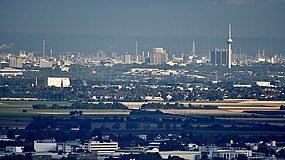
Skyline of Mannheim viewed from Heidelberg.
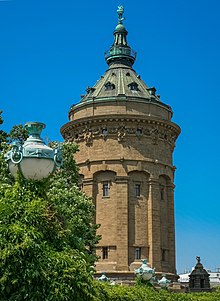
Water tower Mannheim

Mannheim city logo

Aerial view of the city center, which lies between the Rhine and Neckar rivers
Geography
Mannheim is located in the northern Upper Rhine region at the mouth of the Neckar into the Rhine. The city districts are distributed on the right side of the Rhine on both sides of the Neckar.
The city is located in the Rhine-Neckar metropolitan region, a densely populated area with 2.35 million inhabitants, which includes parts of southern Hesse and the Rhineland-Palatinate Vorderpfalz region in Baden-Württemberg, the two urban districts of Mannheim and Heidelberg, and the western and southern municipalities of the Rhine-Neckar district.
Within the Rhine-Neckar region, Mannheim, along with Heidelberg, forms a regional center, of which a total of 14 are designated for all of Baden-Württemberg according to the 2002 state development plan. The regional center of Mannheim assumes the function of a central area for the municipalities of Edingen-Neckarhausen, Heddesheim, Ilvesheim and Ladenburg. There are also links with municipalities in Hesse and Rhineland-Palatinate and the central areas there.
Nearest major cities are Frankfurt am Main, about 70 kilometers to the north, Karlsruhe, about 50 kilometers to the southwest, and Stuttgart, about 95 kilometers to the southeast.
Due to its location directly on the Baden-Württemberg border with Rhineland-Palatinate and Hesse, Mannheim is the only major city in Germany besides the city-state of Hamburg that borders directly on two states.
City breakdown
The urban area of Mannheim is divided into six inner and eleven outer city districts:
- City center/Jungbusch
- Lindenhof
- Neckarstadt East
- Neckarstadt-West
- Neuostheim/Neuhermsheim
- Schwetzingerstadt/East City
as well as
- Feudenheim
- Friedrichsfeld
- Käfertal
- Neckarau
- Rheinau
- Sandhofen
- Schönau
- Seckenheim
- Vogelstang
- Waldhof
- Wallstadt
The city districts are further subdivided into neighborhoods and statistical districts.
See also: List of city districts and neighborhoods of Mannheim
In each of the 17 city districts there is a district advisory council, which consists of 12 citizens living there, who are appointed by the municipal council according to the voting results of the municipal council election. They are to be consulted on important matters affecting the borough and advise the local administration as well as committees of the municipal council. Since 2008, the district advisory councils have had their own budget, the use of which they can decide themselves within defined limits.
City center: The "squares
→ Main article: Square City
Mannheim's horseshoe-shaped city center between the Rhine and Neckar rivers is laid out as a grid, the "Mannheim Squares". Bismarckstrasse runs in front of the front of the castle and connects the ends of the ring road sections. In between, there are streets laid out at right angles. The planning of this network goes back to Elector Friedrich IV of the Palatinate around 1600.
The city center is crossed by two broader main axes. The Kurpfalzstraße, also known as "Breite Straße", runs in a northeast-southwest direction from the castle to the Neckartor. At Paradeplatz, it meets the main shopping street, the "Planken", which runs in an east-west direction. As a rule, the streets in the city center do not have names; instead, the intervening squares are named using a combination of letters and numbers.
The arrangement was originally rather fortress-related: if necessary, it made it possible to fire cannons across the city at enemy formations that had penetrated the fortress. The Mannheim squares and especially the so-called Breite Straße also emphasize the "new" castle, which, however, was not built until later. Therefore, the urban dominance of the residence created by means of the street arrangement is interpreted as a reflection of the absolutist form of government.
The principles of an ideal city were implemented in various residence cities of the absolutist baroque period, such as Erlangen, Glückstadt or Karlsruhe. But also in more recent times, attempts were made to combine ideals and architecture (planned city, planned capital).
Neighboring communities
The following cities and municipalities border the city of Mannheim. They are named clockwise starting in the north:
- Lampertheim and Viernheim (both Bergstrasse district in Hesse),
- Heddesheim, Ilvesheim, Edingen-Neckarhausen, Heidelberg, Plankstadt, Schwetzingen, Brühl (all except the independent city of Heidelberg in the Rhine-Neckar district) in Baden-Württemberg
- as well as Altrip, Ludwigshafen am Rhein, Frankenthal (Pfalz) and Bobenheim-Roxheim (all with the exception of the independent cities of Ludwigshafen am Rhein and Frankenthal (Pfalz) in the Rhein-Pfalz district) in Rhineland-Palatinate.
Area allocation

According to data from the State Statistical Office, as of 2015.
Nature Conservation
→ Main article: List of nature reserves in Mannheim
The following nine nature reserves exist in the Mannheim city area. Thus, 699.4 hectares of the city area are under nature protection, which is 4.8%.
- Backofen-Riedwiesen: 147.7 ha (of which 84.0 ha in the Mannheim urban area)
- Ballauf-Wilhelmswörth: 340.9 ha
- By the silver poplar: 8.7 ha
- Hirschacker and Dossenwald: 128.9 ha (of which 67.5 ha in the Mannheim urban area)
- Head pool on the Friesenheimer Altrhein: 20.1 ha
- Tear island: 108.2 ha
- Lower Neckar: Mulberry Island: 10.6 ha
- Lower Neckar: Wörthel: 20.9 ha
- Cattle wood, apple chamber, new wood: 38,5 ha
Climate
Due to its location in the Upper Rhine Graben, protected by the Palatinate Forest and the Odenwald, Mannheim has a very mild climate by Central European standards. Measurements at the DWD climate station in Mannheim-Vogelstang showed an average temperature of 10.5 °C between 1971 and 2000. The warmest month is July with an average of 19.9 °C, the coldest January with 1.8 °C. Temperatures above 30 °C are not uncommon in midsummer. The peak value was measured on August 7, 2015, at 39.8 °C (measured by the DWD weather station; a private weather station in Mannheim-Seckenheim came in at 40.1 °C on August 8, 2003).
The low amount of precipitation in Mannheim for western Germany is striking. Over the course of a year, an average of only 668 mm of precipitation falls. The peak month is again July. Favored by the Rhine and Neckar rivers, fog banks can occur, especially in the fall. The two rivers as well as floodplain landscapes along the Rhine also ensure above-average humidity, which can lead to oppressive, bioclimatically stressful sultriness, especially in midsummer.
| Mannheim | ||||||||||||||||||||||||||||||||||||||||||||||||
| Climate diagram | ||||||||||||||||||||||||||||||||||||||||||||||||
| ||||||||||||||||||||||||||||||||||||||||||||||||
| Monthly average temperatures and precipitation for Mannheim
Source: DWD, data: 2015-2020 | |||||||||||||||||||||||||||||||||||||||||||||||||||||||||||||||||||||||||||||||||||||||||||||||||||||||||||||||||||||||||||||||||||||||||||||||||||||||||||||||||||||||||||||||||||||||||||||||||||||||||||||||||||||||||||||||||||||||||||||||||||||||||||||||||||||||||||
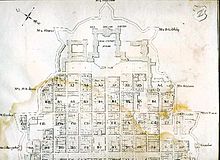
Floor plan from 1799, upper half
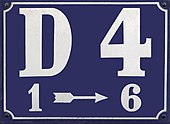
Street sign in Mannheim squares

Downtown scheme
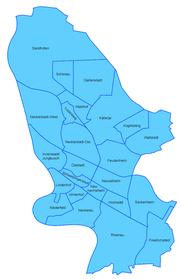
Districts of Mannheim (clickable map)
History
→ Main article: History of Mannheim
The beginnings
A brick kiln excavated in 1929 in the Seckenheim district, which operated from 74 AD to the early second century, attests to settlement in Roman times.
The village of Mannenheim (= home of Manno) was first mentioned in the Lorsch Codex in 766.
Through numerous donations within a short period of time, Lorsch Monastery received 160½ days of arable land, which corresponds to the hay yield of a medium-sized royal farm.
In 1284 Mannheim fell to the Count Palatine of the Rhine from the House of Wittelsbach. The customs castle of Eichelsheim, which was built in 1349 on the site of today's Lindenhof, gained regional importance as it demanded a toll from the Rhine boatmen. In 1415, the deposed antipope John XXIII was imprisoned there on behalf of Emperor Sigismund. By defeating the army of his allied opponents, the Count of Württemberg, the Margrave of Baden and the Bishop of Metz, at the Battle of Seckenheim in 1462, Elector Frederick of the Palatinate "the Victorious" established the Palatine supremacy in the middle Upper Rhine. In 1566, Mannheim was one of the largest villages of the Oberamts Heidelberg with about 700 inhabitants.
Emergence of the city
Mannheim was granted city privileges on January 24, 1607, after Elector Friedrich IV of the Palatinate laid the foundation stone for the construction of the Friedrichsburg fortress on March 17, 1606. The planning at that time of a grid-like street network for the burgher city of Mannheim, which was connected to the fortress, has been preserved. During the Thirty Years' War (1618-1648), in which Mannheim fought on the side of the Protestant Union, it was first destroyed by troops in 1622. War and epidemics caused serious population losses in Mannheim, which had about 1200 inhabitants in 1618. On his return to the Electoral Palatinate in 1649, Elector Karl Ludwig von der Pfalz found a country largely depopulated and economically ruined by the destruction of war. The new regent was resolutely committed to the reconstruction of Mannheim, which was destined to become the center of industrial activity and trade in the Electoral Palatinate because of its favorable location at the mouth of the Neckar River on the Rhine. During the War of the Palatinate Succession, Mannheim was conquered by French troops in 1688 and completely destroyed in March 1689, and the population was expelled. After this destruction, Elector Johann Wilhelm was largely responsible for the renewed reconstruction. Even before the peace treaty was signed, the Elector issued a proclamation in 1697 ordering the reconstruction of the city and calling on the refugees to return. After the reconstruction work began, the population increased again quite quickly.
Residence city of the Electoral Palatinate
In 1720, Elector Carl Philipp moved his court from Heidelberg to Mannheim and began building Mannheim Castle (completed together with the Jesuit Church in 1760). Mannheim became the royal seat of the Electoral Palatinate, and a glorious period of splendor began for the city, which now had a population of 25,000 and lasted only 58 years.
The Electoral Palatinate court promoted art and music, science and trade. Goethe, Schiller and Lessing stayed in Mannheim, as did Mozart.
In 1778, Elector Carl Theodor moved his residence to Munich to take up his Bavarian inheritance. This marked the beginning of an economic and cultural bloodletting in Mannheim.
Baden industrial city
In 1795, the city was occupied by the French and subsequently recaptured by Austrian troops. In 1803 Mannheim finally lost its political position: In the course of the Reichsdeputationshauptschluss, the city fell to Baden, in which it - geographically pushed to the northwestern edge - had only the status of a border town.
In the climatic catastrophe of the "year without a summer" in 1816, which was caused by the eruption of the Tambora volcano and resulted in famine and the death of horses, Karl Drais invented the two-wheeler and thus mechanized individual transport. In 1828 the Rhine harbor was opened, and in 1840 the first Baden railroad line from Mannheim to Heidelberg. Characterized by the economic rise of the bourgeoisie, Mannheim gradually began to flourish again. In the March Revolution of 1848, the city was a center of the political and revolutionary movement. In 1865, Friedrich Engelhorn founded the Badische Anilin- und Soda-Fabrik (BASF), although it was later moved to Ludwigshafen. The dye factory became the largest chemical company in the world. In 1880, Werner von Siemens presented the world's first electric elevator in Mannheim. In 1886, Carl Benz patented his velocipede with gas engine operation. In 1909, Karl Lanz and Johann Schütte founded the Schütte-Lanz company, which built a total of 22 airships. The company was the main competitor of Zeppelin-Werke. After World War I, Heinrich Lanz AG introduced the Bulldog, the most successful heavy oil tractor. The pre-chamber diesel engine invented by Prosper L'Orange at Motorenwerke Mannheim was further developed at Benz & Cie into the world's first compact vehicle diesel engine in 1923. In 1922, the large power plant in Mannheim went into operation. Around 1930, the city had a population of 385,000, together with its sister city Ludwigshafen, which developed from Mannheim's old Rhine redoubt.
From the Third Reich until today
During the Third Reich, almost 2,000 Mannheim residents with a Jewish background were deported. There were around 140 places in the city where forced laborers were housed, many also near the large companies that employed forced laborers and prisoners of war during the Nazi era. In the Sandhofen district, there was one subcamp each of the Natzweiler-Struthof concentration camp and the Hinzert concentration camp.
Mannheim was almost completely destroyed by air raids on Mannheim during World War II. The city was finally occupied by US troops at the end of March 1945. The war, which was still continuing elsewhere in Germany, ultimately ended only on May 8 with the unconditional surrender of the Wehrmacht.
The reconstruction of the city began only with difficulty. The castle and water tower were rebuilt, and the National Theater was erected on a new site. A Schiller monument and the pub Zum Zwischen-Akt stand on the old site. The housing shortage led to the development of numerous new residential areas.
In 1964, the Municipal Hospital on the Neckar became the Faculty of Clinical Medicine Mannheim at the University of Heidelberg. In 1967, Mannheim became a university city.
In 1975, the Federal Garden Show was a highlight in Luisenpark and Herzogenriedpark. A number of structural measures were implemented: the telecommunications tower and a second Rhine bridge were built, the Planken became a pedestrian zone, the new Rose Garden was inaugurated, and the Aerobus floated through Mannheim. A number of major projects were also realized in the 1980s and 1990s: the planetarium, the Kunsthalle extension, the new Reiß Museum, the Stadthaus, the new Maimarkt site, the synagogue, the mosque, the State Museum of Technology and Labor (Technoseum), the Carl Benz Stadium and the Fahrlachtunnel were opened.
In May/June 1992, there were days of riots on the occasion of the accommodation of refugees in the (now demolished) Gendarmerie barracks in the Schönau district (see List of anti-refugee attacks in Germany 1990 to 2013#1992).
Economically, Mannheim has been characterized in the recent past by a decline in industrial jobs. The city tried to shape this structural change by designating industrial estates and attracting service companies. A prime example is the construction of the Victoria high-rise in 2001, one of the tallest buildings in the city, on the railroad site.
In view of the 400th city anniversary in 2007, a number of urban development activities were implemented from 2000 onward: SAP Arena with connection to the new eastern light rail ring, redevelopment of the Breite Strasse pedestrian zone, the Zeughaus and the castle, complete redesign of the Alter Meßplatz and the new Schafweide light rail line. The concept of the city anniversary aimed at a diverse spectrum of events without a dominating central event.
During the 2015 refugee crisis in Europe, Mannheim took in 12,000 refugees, mostly in former U.S. Army barracks.
See also: Jewish Community Mannheim
→ Main article: List of bunkers in Mannheim
Incorporations
Between 1895 and 1944, several surrounding villages were incorporated into Mannheim, including Neckarau, which was the largest village in Baden at the time. During the major municipal reform in the 1970s, there were plans to incorporate Brühl, Ilvesheim, Edingen-Neckarhausen and Ladenburg. However, due to large protests, they refrained from doing so, and Mannheim was one of the few cities in Baden-Württemberg that did not receive an increase in area. Before the first incorporation, the city area covered 2384 hectares:
| Year | Places | Increase in hectares |
| 1895 | Friesenheim Island | 717 |
| 1897 | Käfertal | 1777 |
| 1899 | Neckarau | 1575 |
| 1910 | Feudenheim | 781 |
| 1913 | Sandhofen | 2437 |
| 1913 | Rheinau | 959 |
| 1929 | Wallstadt | 674 |
| 1930 | Seckenheim | 1687 |
| 1930 | Friedrichsfeld | 225 |
| 1930 | Kirschgartshausen | 489 |
| 1930 | Sand peat | 264 |
| 1930 | Street home | 406 |
| 1944 | Rohrhof district (in part) | 233 |
Population development
→ Main article: Population development of Mannheim
The population of the city of Mannheim exceeded 100,000 in 1896, making it a major city. In 1905, the city had over 160,000 inhabitants, and by 1961 this number had doubled. In 1970, the population reached its historic high of around 333,000. Due to migration losses to the surrounding areas and a negative birth and death rate, the number of inhabitants dropped to around 295,000 by 1986. Currently, the increased influx into metropolitan areas also applies to Mannheim.
For December 31, 2015, the Municipal Statistics Office of the City of Mannheim lists 337,919 residents, of which 317,744 are primary residents.
The proportion of foreigners is 25.2% (79,963 persons) in relation to their main place of residence. Taking into account naturalized persons and ethnic German immigrants, 138,428 residents (43.6%) have a migration background. The largest immigrant groups come from:
|
|
In the individual city districts, the proportion of residents with a migration background is:
|
|
Religions and worldviews
Denomination statistics
According to the 2011 census, at that time 29.8% of the city's population was Catholic, 26.5% Protestant, and 43.7% belonged to another religious community or to no religious community under public law (adjusted register population). The number of Protestants and Catholics has decreased since then and the persons who do not belong to any religious community under public law are an absolute majority of the population. The current distribution of the city's population by religious affiliation (as of December 31, 2020) is Roman Catholic 25.4%, Protestant 20.0%, and other/none 54.6%.(53.5% in 2019)
Precise figures on other religious communities (in addition to the two official churches) were last collected in the 2011 census: At that time, 0.7% of the population were Evangelical Free Churches, 2.6% Orthodox. According to a calculation based on the census figures for persons with a migration background, Muslims accounted for 10.8% of the population in 2011.
Protestants
Elector Ottheinrich introduced the Reformation of the Lutheran confession in the Electoral Palatinate by mandate of April 4, 1556, after his predecessor Frederick II had already made serious efforts in this direction ten years earlier (first Lutheran communion in the Heiliggeistkirche in Heidelberg on April 18, 1546). Under Ottheinrich's successor Friedrich III, the Electoral Palatinate switched to the Reformed confession of Calvinist character from 1561 (Heidelberg Catechism 1563). The time of the founding of the city of Mannheim thus fell into the phase of Electoral Palatine Reformedism, which gave the city a Reformed-Protestant character for a long time.
In 1821, the union between Lutheran and Reformed congregations was carried out in the Grand Duchy of Baden. In 2005, the first youth church of the Protestant regional church of Baden was opened in the Waldhof district. With the incorporation of the previously independent Evangelische Kirchengemeinde Friedrichsfeld in 2008, all Protestant congregations, unless they belong to a free church, are part of the Mannheim church district within the Nordbaden church district of the Evangelische Landeskirche in Baden. The church district of North Baden has its seat in Schwetzingen.
Catholics
The first churches can be traced back to the 8th century in the suburbs of Scharhof, Wallstadt and Feudenheim. A parish in Mannheim itself was first mentioned in the 14th century. It belonged to the diocese of Worms and was dedicated to St. Sebastian. The oldest Catholic church is the parish church of St. Sebastian on the market square, which was completed in 1723. In 1729, Elector Karl Philipp donated 100,000 florins for the construction of the Jesuit Church, which was to serve as the court church. Together with the Liebfrauenkirche, it has belonged to a joint parish of St. Sebastian since 2005. The other 28 Roman Catholic parishes are grouped into ten pastoral units and belong to the Mannheim City Deanery of the Archdiocese of Freiburg.
Other churches
There are also several Orthodox parishes, including the Russian Orthodox Church of St. Alexander Nevsky and the Greek Orthodox Church of the Exaltation of the Holy Cross.
Protestant free churches are also numerous. These include, for example, the Free Evangelical Church (FEG), the congregation Haus des Herrn (HdH-Mannheim) in Mannheim-Rheinau, the Free Church of the Seventh-day Adventists (STA) and the Evangelical Free Church (Baptist). Their Hope Church has been located in the Neckarstadt district since 1961.
The congregation of the Old Catholic Church has been at home since 1873 in the Schlosskirche and in Mannheim's only blue church, the Erlöserkirche Gartenstadt.
In addition, there are other Christian denominations in Mannheim today, including the New Apostolic Church, Jehovah's Witnesses, and a Free Religious congregation that was founded during the Baden Revolution in the mid-19th century.
Jews
→ Main article: Jewish community Mannheim
The first synagogue was built in Mannheim in 1660. Especially after the destruction of the city in the 17th century, the electors specifically promoted the settlement of Jews with tax concessions and the privilege of freedom of trade to help trade and crafts flourish. In 1719, 10.6% of the population were Jewish. By 1895, the Jewish community had grown to 4768 members. However, the rest of the population grew even more rapidly, so that after 1900 the Jewish proportion was only around three percent. In 1933, 6402 Jews lived in Mannheim, forming the largest community in Baden.
Due to the repressive measures after the National Socialists seized power, many Jews found themselves in need at an early stage. As early as 1933, the mayor at the time, Carl Renninger (NSDAP), forbade the awarding of contracts to Jewish companies. Jewish lecturers at the local commercial college were suspended, the Mannheim National Theater dismissed Jewish actors, and Jewish doctors had their health insurance licenses revoked. Many families emigrated abroad, especially to the United States. After the devastation of the three Mannheim synagogues in 1939, about 2000 and thus almost all remaining Jews were deported to Gurs in 1940. Most were deported from there to the German concentration camps in occupied Poland and murdered.
After the Second World War, only a few emigrants returned to Mannheim. The re-establishment of the Jewish community after the Nazi persecution took place with only 120 members. The new synagogue of the Jewish community was opened in 1987. In 2012, the community had about 500 members.
Muslims
With the second wave of guest workers in the mid-1960s, many immigrants from Turkey came to Mannheim, and with them a significant number of Muslims for the first time. Their number rose to 20,827 by 2004, seven percent of Mannheim's population, the majority of them being immigrants from Muslim countries and their descendants. In 1995, therefore, the Yavuz Sultan Selim Mosque, by then the largest mosque in Germany, was built, offering 2,500 places for prayer. In 2005, the minaret, which had already fallen into disrepair, was rebuilt slimmer and taller. In 2010, the Ehsan Mosque of the Ahmadiyya Muslim Jamaat was built in Mannheim-Casterfeld. There are also other mosques in the districts of Innenstadt/Jungbusch (three), Neckarstadt-West (two) and Neckarstadt-Ost, Waldhof, Neckarau, Rheinau and Hochstätt (one each).
Evolutionary Humanism
The Giordano Bruno Foundation, which represents Evolutionary Humanism, is represented by the Secular Humanists - gbs Rhein-Neckar e. V., founded in Mannheim in 2010.

Yavuz Sultan Selim Mosque in Jungbusch district
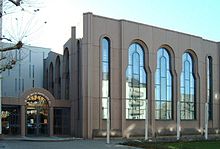
Mannheim synagogue in F3
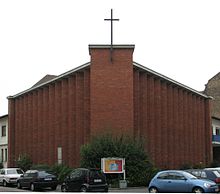
Hope Church of the Evangelical Free Church Congregation
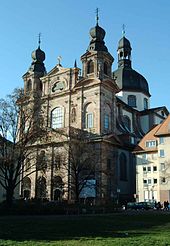
Jesuit church in A4

Population development of Mannheim from 1871 to 2017
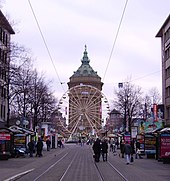
Pedestrian zone "Planken

Pedestrian zone "Breite Straße
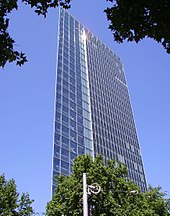
Victoria Tower
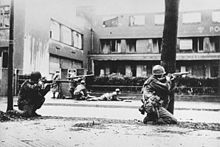
U.S. troops fighting in the streets of Mannheim, 1945

The former Friedrichschule, today Gustav-Wiederkehr-Schule (middle building), served as a concentration camp outpost

Historical map of Mannheim 1880
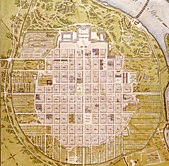
Mannheim 1813

Mannheim 1758
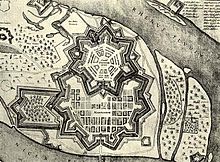
Rhine redoubt and citadel Mannheim in 1620
Politics
Municipal Council
Local council election 2019
in percent
%
30
20
10
0
24,4
21,2
19,1
9,2
7,4
6,1
6,0
3,0
3,6
Green
SPD
CDU
AfD
ML
FDP
Left
PARTEI
Otherwise.
Gains and losses
compared to 2014
%p
10
8
6
4
2
0
-2
-4
-6
-8
+8,1
−6,1
−7,0
+1,4
−1,9
+1,6
−0,2
+3,0
+1,1
Green
SPD
CDU
AfD
ML
FDP
Left
PARTEI
Otherwise.
The municipal council has 48 seats and is elected by direct vote for a five-year term. In addition, there is the mayor, who is the chairman of the municipal council with voting rights. According to Baden-Württemberg's municipal election law, voters have the option of cumulating and selecting candidates.
The 2019 municipal election resulted in the following (in parentheses: difference from 2014):
| Local council election 2019 | ||||
| Party/voter group | Voices | Seats | ||
| GREEN | 24,4 % (+8,1) | 12 (+4) | ||
| SPD | 21,2 % (−6,1) | 10 (−3) | ||
| CDU | 19,1 % (−7,0) | 9 (−3) | ||
| AfD | 9,2 % (+1,4) | 4 (±0) | ||
| FW-ML | 7,4 % (−1,9) | 4 (±0) | ||
| FDP | 6,1 % (+1,6) | 3 (+1) | ||
| THE LEFT. | 6,0 % (−0,2) | 3 (±0) | ||
| The PARTY | 3,0 % (+3,0) | 1 (+1) | ||
| Medium-sized companies for Mannheim (MfM) | 1,3 % (−0,1) | 1 (±0) | ||
| Animal Protection Party | 1,1 % (+1,1) | 1 (+1) | ||
| Other | 1,2 % (+0,1) | 0 (−1) | ||
| Voter turnout: 49.8 % (+11.1) | ||||
See also: Results of the local elections in Mannheim
Mayor
The city administration is headed by the mayor, who is also the chairman of the municipal council. He is elected by direct vote for a term of eight years. The incumbent mayor is Peter Kurz (SPD), who was elected in the first round of the 2007 mayoral election with 50.53% and a voter turnout of 36.64%.
The first round of the 2015 mayoral election took place on June 14. The incumbent, supported by the SPD, the Greens and Die Linke, achieved 46.8%. The results of the challengers: Christopher Probst (Mannheimer Liste) 15.9%, Peter Rosenberger (CDU) 33.8% and Christian Sommer (Die Partei) 3.3%. Other elected parties received 0.2%. The voter turnout was 30.7 %. As no candidate achieved the required absolute majority, the decision was made in a 2nd ballot on July 5, 2015 between incumbent Kurz and Rosenberger. There, a simple majority was sufficient in accordance with the election principles set out in the Baden-Württemberg municipal code. Peter Kurz achieved 52% of the votes cast in the run-off election and thus remained Lord Mayor.
The Lord Mayor is assisted by a First Mayor (also Deputy Lord Mayor) and four other mayors. They are elected by the city council for a term of eight years and therefore reflect the party-political majority at the time of the election. Each mayor heads a department in the city administration:
- As First Mayor, Christian Specht (CDU) is responsible for finances, assets, security and order.
- Michael Grötsch (CDU) heads the Department of Economics, Labor, Social Affairs and Culture.
- Dirk Grunert (Greens) is responsible for education, youth, family and health.
- Lothar Quast (SPD) is responsible for construction, planning, transport and sports.
- Felicitas Kubala (Bündnis 90/Die Grünen) heads the Department for Citizen Services, Environment and Technical Operations.
The total number of employees of the city administration is about 7100 people.
The heads of the town since 1810 were:
|
|
Bundestag
In the federal election on September 24, 2017, Nikolas Löbel (CDU) won the direct mandate in constituency 275 with 29.3%, followed by candidates Stefan Rebmann (SPD) with 27.9% and Gerhard Schick (Bündnis 90/Die Grünen) with 13.1% of the primary vote. Schick, like Gökay Akbulut (DIE LINKE), entered the Bundestag via the state lists of their parties.
The CDU was also ahead of the SPD (21.2%) in the second vote in Mannheim with 27.1%.
Established candidates for the 2021 federal election: Isabel Cademartori (SPD), Melis Sekmen (Bündnis 90/Die Grünen) and Konrad Stockmeier (FDP).
Coat of arms
|
| Blazon: "Split of gold and black, in front a standing red double hook (wolf's tang), behind a red-armored, -bejeweled and -crowned double-tailed golden lion." |
| Coat of arms justification: The coat of arms was established by the city council in 1896 and confirmed by the Grand Duke of Baden. The Wolfsangel is provable since the 17th century on a Gemarkungsgrenzstein. It is probably a mark of a spot. The lion is the Kurpfälzische Löwe, the heraldic animal of the Electors of the Palatinate, whose residence city Mannheim was from 1720. Both heraldic images appear in the seals of the city since the 18th century. The city usually uses the coat of arms in a simplified form in the style of the New Objectivity. |
The city colors blue-white-red have been in use only since the 19th century and point to a seal string from 1613. The city colors are not derived from the coat of arms colors, which is completely unusual.
At the beginning of 2003, the city administration adopted a new logo for outdoor advertising: Mannheim in a Square. It shows a red square with the number two inside in white in the sans serif semi-bold font FF Kievit and is intended to symbolize the squaring of the streets in the city center. But equally, the superscript 2 is also meant to stand for the city's potential, "culture to the power of two," "science to the power of two," and "Mannheim is life to the power of two."
See also: List of coats of arms in Mannheim
Town twinning
Mannheim is twinned with the following cities:
- United Kingdom
 Swansea, United Kingdom, since 1957
Swansea, United Kingdom, since 1957 - France
 Toulon, France, since 1959
Toulon, France, since 1959 - Germany
 Berlin district Charlottenburg-Wilmersdorf, since 1961 with district Charlottenburg
Berlin district Charlottenburg-Wilmersdorf, since 1961 with district Charlottenburg - Canada
 Windsor, Canada, since 1980
Windsor, Canada, since 1980 - Germany
 Riesa, Saxony, since 1988
Riesa, Saxony, since 1988 - Moldova Republic of
 Chișinău, Moldova, since 1989
Chișinău, Moldova, since 1989 - Poland
 Bydgoszcz, Poland, since 1991
Bydgoszcz, Poland, since 1991 - Lithuania
 Klaipėda (until 1923: dt. Memel), Lithuania, since 2002 (sponsorship with Memel existed since 1915)
Klaipėda (until 1923: dt. Memel), Lithuania, since 2002 (sponsorship with Memel existed since 1915) - China People's Republic of
 Zhenjiang, People's Republic of China, since 2004
Zhenjiang, People's Republic of China, since 2004 - Israel
 Haifa, Israel, since 2009
Haifa, Israel, since 2009 - China People's Republic
 Qingdao, People's Republic of China, since 2016
Qingdao, People's Republic of China, since 2016
There are also friendship treaties (1989) with El Viejo in Nicaragua and (2011) with Beyoğlu, a district of Istanbul. In December 2013, Mannheim and Hebron (Palestinian Territories) concluded a cooperation agreement initially for two years.
Neighborhood Association
Mannheim is part of the Heidelberg-Mannheim Neighborhood Association, whose task is to prepare the regional land use plan.
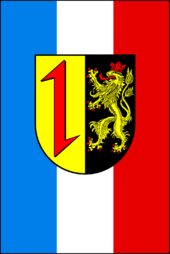
Mannheim city flag

Lord Mayor Peter Kurz (SPD)

City hall in E5
Economy and infrastructure
Economy
In the 2016 Future Atlas, the independent city of Mannheim ranked 52nd out of 402 administrative districts and independent cities in Germany, making it one of the places with "high future opportunities". In the 2019 edition, it was ranked 35th out of 401.
In 2017, of the 185,371 employees subject to social security contributions, 27.9% worked in the manufacturing sector, 22.7% in trade, hospitality and transport, and 49.2% in other services. In 2016, Mannheim produced, within the city limits, a gross domestic product (GDP) of €19.685 billion, placing it 18th in the ranking of German cities by economic output. Its share of the economic output of Baden-Württemberg was thus 4.1%. GDP per capita in the same year was €64,483 (Baden-Württemberg: €43,632, Germany €38,180), well above the regional and national average. In 2016, the city's economic output recorded a nominal growth of 3.8%. There were approximately 243,000 employed persons in the city in 2016. The unemployment rate was 6.2% in January 2020, above the Baden-Württemberg average of 3.5%.
Although Mannheim has been characterized by a profound structural change since the 1970s at the latest, marked by a reduction of industrial jobs and an increase in the service sector, the metal and chemical industries are still very much present.
The electrical and mechanical engineering industries are the strongest. The largest companies include:
- Daimler (engines)
- EvoBus (buses and coaches)
- ABB (electrical and automation engineering)
- General Electric (power plants)
- Bombardier (electrical equipment for railcars)
- John Deere (agricultural machinery)
- Caterpillar Energy Solutions (formerly MWM, Motorenwerke Mannheim)
- Pepperl+Fuchs (Factory and Process Automation)
- WIMA (electronic components)
The chemical industry is represented by:
- Roche (Pharmaceuticals and Diagnostics)
- Essity (cellulose and paper products such as Zewa)
- Fuchs Petrolub (lubricants)
- Unilever (Dove soaps)
- Reckitt Benckiser (household cleaners)
- Phoenix (pharmaceutical trade)
- German Hutchinson (rubber products)
The financial center of Mannheim is no longer a leader as it was around 1900, but it still has great importance, especially with its insurance companies. Mannheimer Versicherungen and Inter Versicherungsgruppe have their headquarters here. One of the four corporate headquarters of LBBW is located in Mannheim, Neue Rechtsschutz Versicherung maintains a central claims office, SV SparkassenVersicherung has an important branch office, and Ergo Versicherungsgruppe also has a location here.
The food industry is represented by Südzucker, Birkel pasta, the private brewery Eichbaum, Pfalzmühle Mannheim (a PMG Premium Mühlen Group company) and Bunge Germany (oil and grain seed processing).
Bilfinger and Diringer & Scheidel belong to the construction industry, while Bauhaus and Engelhorn are represented from the retail sector.
The publishing house Edition-Panorama, made famous by the New-York Vertical series by Mannheim photographer Horst Hamann, and Huber Verlag, publisher of TatowierMagazin and Bikers News, among others, are based in Mannheim. In addition, the Bibliographisches Institut & F. A. Brockhaus (Brockhaus, Duden, Langenscheidt, Meyer) used to be based in Mannheim.
MVV Energie is the largest municipal energy supplier in Germany. The Berrang Group is a major international player in mechanical fastening technology.
Large trade fairs are held regularly at the Mannheim Maimarkt grounds. The most important is the 400-year-old Mannheim Maimarkt, which is Germany's largest regional consumer exhibition with 1400 exhibitors and 350,000 visitors. But Europe's largest classic car market, the Veterama, also takes place every year on the Maimarkt grounds.
Traffic
Street
→ Main article: Road traffic in Mannheim
The Mannheim/Ludwigshafen agglomeration is surrounded by a ring of highways with a total of seven interchanges. In the north and east, the federal highway 6 (Saarbrücken-Nuremberg) surrounds the city area, and the highway ring is completed by the A 61 to the left of the Rhine in the west and south of Ludwigshafen. In the northeast of Mannheim, the A 67 branches off to Darmstadt and Frankfurt, in the east the A 656 to Heidelberg and the A 659 to Weinheim. Further to the east, the A 5 (Frankfurt-Basel) runs parallel. Federal highways 36, 37, 38, 38a and 44 run through the city.
Rail / Public transport
→ Main article: Local transport in Mannheim
Mannheim is the second largest rail hub in southwestern Germany. In 2010, 238 long-distance trains stopped at the main station every day, providing direct connections to Hamburg, Berlin and Cologne, among others. Since 1991, there has been a fast and efficient ICE connection to the Stuttgart region via the Mannheim-Stuttgart high-speed line.
With the new Rhine/Main-Rhine/Neckar line, a comparable connection to the neighboring Rhine-Main region is being planned, after trains coming from Frankfurt have already been able to stop without having to turn around in the main station since the opening of the Western Introduction of the Riedbahn (WER) in 1985. Since 2007, the European high-speed rail link Paris-Frankfurt (LGV Est européenne) has passed through Mannheim.
The marshalling yard is the second largest in Europe after Maschen. In 2005, 30 international, 60 national and 440 regional freight trains were handled daily.
The RheinNeckar S-Bahn has been in operation since 2003, providing access to almost the entire Rhine-Neckar region and running lines as far as the Palatinate, the Odenwald and southern Hesse. Four of the seven S-Bahn lines run via Mannheim's main station.
Public transport in Mannheim has been provided by the streetcar since 1878. Ten light rail lines and numerous bus lines of the RNV are in operation today. All means of public transport can be used at uniform prices within the Rhine-Neckar transport association. The Mannheim-Ludwigshafen subway network, which was started in the 1970s, was not realized except for small sections for cost reasons. The only underground station in Mannheim is the Dalbergstraße stop. The subway plans have since been discontinued.
Water
Favored by the confluence of the Rhine and Neckar rivers, the Port of Mannheim, with an area of 1,131 hectares, is today one of the most important and largest inland ports in Europe. In 2016, 6.9 million tons of goods were handled on the water side. Almost 500 companies with 20,000 jobs are located in the port area.
Air
Mannheim has a commercial airport, Mannheim Airfield, located in the Neuostheim district. There are currently twice-weekly scheduled flights to Berlin-Tegel Airport and Hamburg Airport, operated by Rhein-Neckar Air. Until December 2012, scheduled services were operated by Cirrus Airlines. Frankfurt International Airport is 65 kilometers to the north and can be reached by ICE train in 30 minutes.
Media
→ Main article: Media in the Rhine-Neckar Triangle
In addition to the only local daily newspaper Mannheimer Morgen, the Ludwigshafen Rheinpfalz, the Heidelberg Rhein-Neckar-Zeitung and the Bild Rhein-Neckar offer a local section for Mannheim. In addition, the weekly paper "Wochenblatt Mannheim" with its official gazette is published weekly. The Kommunal-Info Mannheim is published fortnightly. Free district newspapers are distributed in almost all parts of the city.
As a regional television station for the Rhine-Neckar triangle, Rhein-Neckar Fernsehen is based here. Mannheim is also home to a studio of Südwestrundfunk (SWR). Among other things, the regional program Kurpfalz-Radio of SWR4 is broadcast from here. Also based in Mannheim are the private radio stations bigFM, Radio Regenbogen and sunshine live. Since 2000, bermuda.funk - das Freie Radio Rhein Neckar has been receivable. In 2001, the campus radio station radioaktiv went on the air. From 1993 to 2009, the American Forces Network of the US Armed Forces produced the local program AFN Heidelberg in Seckenheim. From 2009 to 2012, the studios were located at AFN's European headquarters, which moved from Frankfurt am Main to Sandhofen in 2004.
From 1986 to 2012, the city magazine meier was published monthly as a print edition. From 2006 to 2007, Sportwoche Mannheim was published weekly. Both magazines now appear as an online medium.
The media group Dr. Haas, which wholly owns Mannheimer Morgen and a share in Radio Regenbogen and big FM, dominates the local market.
Authorities and institutions
Mannheim had a municipal police force until 1971. Since 1971, the state police of Baden-Württemberg has been responsible for Mannheim. The Mannheim Police Headquarters is headed by Police Chief Andreas Stenger. The police headquarters is responsible for the police stations of Innenstadt, Oststadt, Neckarstadt, Neckarau, Käfertal, Sandhofen and Ladenburg, Wiesloch, Schwetzingen, Eberbach, Hockenheim, Heidelberg-Süd, Heidelberg-Mitte, Heidelberg-Nord, Weinheim, Sinsheim and Neckargemünd, each with their associated police stations. The police headquarters also includes criminal investigation departments and traffic police, as well as a team of service dog handlers. Since 1965, there has been a police music corps at the Mannheim police headquarters.
In addition to the Baden-Württemberg state police, a KOD, Kommunaler Ordnungsdienst, has also been operating since 1998 as a kind of re-emerged municipal police force.
There is an honorary French and Italian consulate in the city. Mannheim is the seat of the office of the Rhine-Neckar Regional Association and the Heidelberg-Mannheim Neighborhood Association. Furthermore, the Chamber of Crafts and the Rhine-Neckar Chamber of Industry and Commerce are located here, whose chamber districts include the city districts of Mannheim and Heidelberg as well as the Rhine-Neckar district and the Neckar-Odenwald district. There is also an employment agency and two tax offices. The Mannheim Prison is the largest in Baden-Württemberg, with over 800 prison places. Due to the number of inhabitants, Mannheim has a fire department consisting of volunteer and full-time forces.
Two major statutory accident insurance institutions have their headquarters in Mannheim: Berufsgenossenschaft Nahrungsmittel und Gastgewerbe and Berufsgenossenschaft Handel und Warendistribution. Mannheim is also the seat of a church district of the Protestant Church in Baden and a deanery of the Archdiocese of Freiburg.
Dishes
Mannheim is home to the Administrative Court of Baden-Württemberg, the appellate court for all administrative courts in the state. The state labor court, with its seat in Stuttgart, has chambers in Mannheim.
Furthermore, the city has a district court and a regional court with patent law chambers, both of which belong to the Karlsruhe Higher Regional Court District, as well as a labor court and a social court.
Clinics
Mannheim has four large hospitals: the University Hospital, the Diakonie Hospital, the Theresien Hospital and St. Hedwig Clinic, and the Central Institute for Mental Health. They are spread over several locations in the city.
Garrison
→ Main article: US Garrison Mannheim
Mannheim was garrison for parts of the Grenadier Regiment 110 (XIV (Baden) Army Corps) of the Prussian Army until 1918. From 1936 onwards, as a result of the rearmament pursued by the Nazi regime, several new barracks were built for the Mannheim Wehrmacht garrison. These continued to be used on a large scale by the US Army during the Cold War period after 1945. At times, several thousand U.S. soldiers were located in Mannheim, including, for example, parts of the 8th U.S. Infantry Division. The Bundeswehr presence was limited to a few smaller units of the territorial army.
A number of important NATO and U.S. Army facilities were located in Mannheim for a long time. However, the move of USAREUR to the new headquarters in Wiesbaden in September 2013 drastically reduced the number of U.S. soldiers and employees. By the end of 2015, all American military facilities in Mannheim are to be closed.
Education
→ Main article: List of educational institutions in Mannheim
The school reformer Joseph Anton Sickinger developed the Mannheim school system at the beginning of the 20th century. Important contributions to education came from him.
Tertiary education
- University of Mannheim, founded in 1907 as a commercial college, has been a university since 1967. Its economics and social sciences regularly occupy top positions in Germany in university rankings. Around 12,000 students are enrolled here.
- Mannheim Medical Faculty, affiliated with Heidelberg University, with 1400 students.
- Federal University of Applied Sciences for Public Administration, founded in 1978. The Bundeswehr Administration Department is located in Mannheim. Around 350 students are enrolled.
- Hochschule der Bundesagentur für Arbeit, created in 2006 from the Federal University of Applied Sciences, offers bachelor's degrees for 900 students.
- Mannheim University of Applied Sciences, originally founded in 1898 as an engineering school, since 1971 University of Applied Sciences for Technology. Following mergers in 1995 with the University of Applied Sciences for Design and in 2006 with the University of Applied Sciences for Social Work, it now has 4,500 students enrolled.
- State University of Music and Performing Arts Mannheim, successor to the Academie de Danse founded in 1762 and a private music school founded in 1776 at the court of Carl Theodor, has about 630 students.
- Freie Hochschule für anthroposophische Pädagogik Mannheim, trains teachers according to the anthroposophical principles of Waldorf education.
- Duale Hochschule Baden-Württemberg Mannheim, founded as a vocational academy as part of a pilot project in 1974, is now one of the largest three locations of the Duale Hochschule Baden-Württemberg with 5,300 students.
- SRH Fernhochschule - The Mobile University, is a state-recognized university with a study center in Mannheim. Since September 2017, students have been able to attend face-to-face events there, take exams or obtain information on site.
- Popakademie Baden-Württemberg, founded in 2003, the institution, which is unique in Germany, offers the degree programs Music Business, Pop Music Design, World Music, Popular Music and Music and Creative Industries.
- Academy for Business Administration and World Trade Languages (ABW), founded in 1956, Private Business School in E1
- Bundesakademie für Wehrverwaltung und Wehrtechnik (Federal Academy of Defense Administration and Technology), founded in 1961, is today the highest central educational institution of the Bundeswehr administration and responsible for career training in the field of defense technology.
- Bundeswehr Administrative School I (Technology), provides basic and advanced training for civil servants in the technical service.
- Theaterakademie Mannheim, is a state-approved vocational school for acting and directing and was founded in 1994. Since 2006, the drama school has been operating under new management.
- College of Business for Management, opened in 2011, is a state accredited college.
- FOM Hochschule für Oekonomie und Management, is the largest private university in Germany. It maintains a location in the Neckarau district.
Quaternary education
- Mannheimer Abendakademie und Volkshochschule, founded in 1899, is one of the oldest adult education centers in Germany. With over 150,000 hours of instruction annually, it is the most powerful adult education center in Baden-Württemberg.
Research centers and institutes
- Institute for German-Turkish Integration Studies: Islamic Studies-Islamic Nutrition, Islamic Pastoral Care-Rhein Neckar Metropol
- Institute for German, European and International Medical Law, Health Law and Bioethics (IMGB), founded in 1998 by the Universities of Heidelberg and Mannheim, is one of Germany's most renowned centers for research in the fields of medical and health law and bioethics.
- Institute for the German Language, founded in 1964, is dedicated to language research.
- Institute for SME Research, has been conducting empirical and interdisciplinary research into the development of the SME economy since 1989.
- Research Foundation for Electrical Systems and Power Economics, promotes the performance, safety and economics of electric power supply.
- Fraunhofer Project Group for Automation in Medicine and Biotechnology, deals with automation solutions in medicine and biotechnology
- Elections Research Group, researches voter behavior and monitors social trends and moods.
- International Institute for Vocational Education and Training Mannheim, subordinate to the Ministry of Education, Youth and Sports Baden-Württemberg
- State Seminar for Didactics and Teacher Education, responsible for elementary and secondary schools
- Mannheim Center for European Social Research, has been researching societal, social and political developments in Europe since its foundation in 1989.
- Center for European Economic Research, has been working in the field of applied empirical economic research since 1991.
- GESIS - Leibniz Institute for the Social Sciences is the largest German infrastructure institution for the social sciences.
- Goethe-Institut, the Goethe-Institut Mannheim is located in the Almenhof district.
- Marchivum (Mannheim City Archive), founded in 1907, researches the history of Mannheim

State University of Music and Performing Arts

University of the Federal Employment Agency

Main entrance of the Faculty of Economics of the University of Mannheim
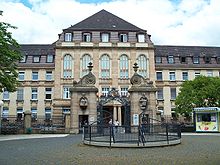
Entrance of the University Hospital
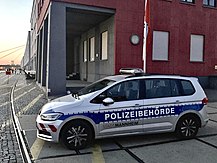
Patrol car of the KOD Mannheim
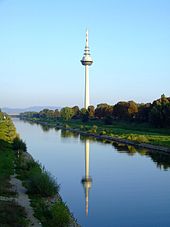
Telecommunications tower
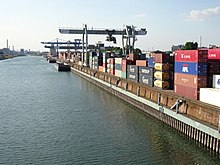
Container port

Mannheim main station
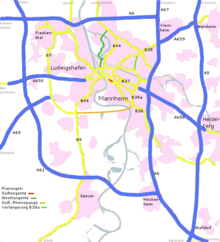
Main roads
.jpg)
An ICE on the western branch of the Riedbahn.
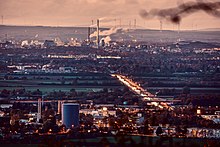
MVV Energie is the largest municipal energy supplier in Germany. Thermal energy from Mannheim is also supplied to Heidelberg in the blue "Thermoskanne" heat storage facility
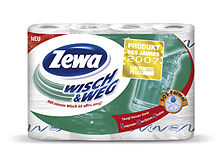
Zewa comes from Mannheim

Bus from Mannheim production

IDS Institute for German Language
Personalities
Numerous well-known personalities were born in Mannheim or have worked here. Since 1820, the city has awarded honorary citizenship 43 times. Mannheim's highest civic award is the Bloomaulorden, which has been awarded annually since 1970.
See also: List of personalities of the city of Mannheim
See also: List of honorary citizens of Mannheim
· 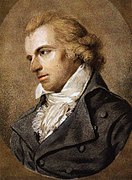
Friedrich Schiller
· 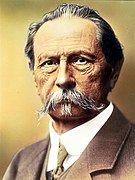
Carl Benz
· 
Sepp Herberger
· 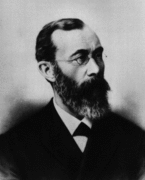
Honorary citizen Wilhelm Wundt
· 
Joy Fleming
Movies
- Red flags - green lawn. Workers' housing estates in Mannheim. Documentary, Germany, 2014, 44:30 min, written and directed by Ursula Schlosser, produced by SWR, first broadcast: July 15, 2013 on SWR, synopsis by SWR, online video available until April 23, 2017.
- Mannheim - A time travel through the 50s and 60s. Documentary, Germany, 2012, 44 min., Director: Eberhard Reuß and Christiane Schmied, Production: SWR, First broadcast: November 1, 2012 on SWR, Synopsis by ARD with online video.
- Mozart in Mannheim. Documentary, Germany, 2008, 29 min, Written and directed by Harold Woetzel, Production: SWR, Series: Musikalischer Reiseführer, First broadcast: May 24, 2010 in Das Erste, Film information from SWR, (Memento from February 12, 2013 in Web Archive archive.today).
- Schiller. TV feature film, Germany, 2005, 90 min., written by Hendrik Hölzemann and Martin Weinhart, directed by Martin Weinhart.
- Picture Book Germany: Mannheim - Opposites Squared. Documentary, Germany, 2002, 43 min., written and directed by Christina Brecht-Benze, produced by SWR, first broadcast: June 30, 2002, NDR synopsis.
- Expedition to the homeland: Mannheim- surprisingly different. SWR, 2021. Written and directed by Fabian Siegel. Broadcast from March 19, 2021
See also
![]()
Portal: Mannheim - Overview of Wikipedia content related to Mannheim
Questions and Answers
Q: What is Mannheim?
A: Mannheim is a city in the southwest of Germany, located in the northwest of the German state of Baden-Württemberg.
Q: Where is Mannheim located?
A: Mannheim is located in the Rhine River valley where the Rhine and Neckar Rivers meet. The city of Ludwigshafen is on the opposite bank of the Rhine.
Q: How many people live in this area?
A: Nearly 2.4 million people live in this area. As of 2020, 309,720 people live in the city itself.
Q: What type of climate does Mannheim have?
A: Mannheim has an oceanic climate (Cfb in the Koeppen climate classification).
Q: What makes Mannheim an important city?
A: Mannheim is an important city because it has a strong business power and culture, as well as good transport connections by road, rail and water. It was also ranked 11th most inventive cities worldwide by Forbes magazine.
Q: When did most of old city get destroyed during World War II?
A: During World War II almost all of the old city was destroyed.
Q: When did construction begin to rebuild after WWII?
A: Construction began to rebuild after WWII ended and continued until 2007 when it celebrated its 400th birthday anniversary.
Search within the encyclopedia
